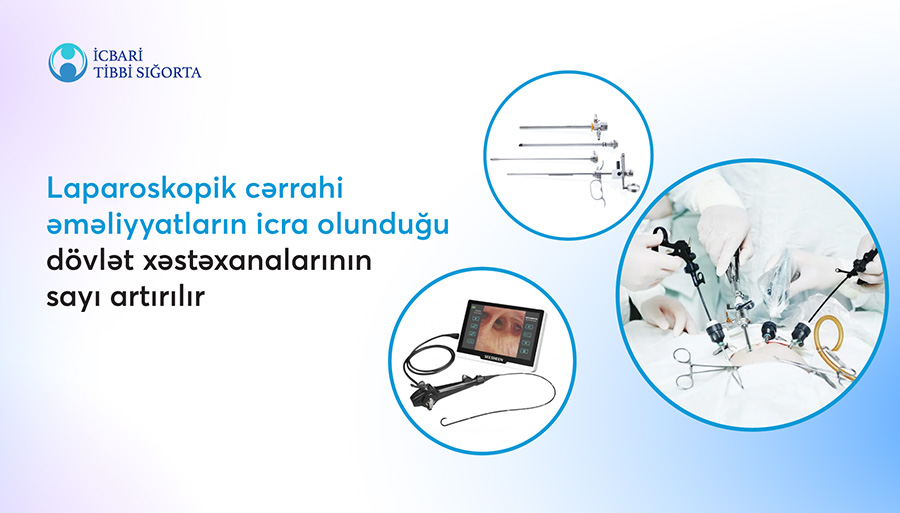17 April 2023 11:48
The number of state hospitals that use laparoscopic surgery technique is increasing
The State Agency on Mandatory Health Insurance (Agency) has purchased 18 sets of laparoscopic equipment, including the necessary tools and accessories for minimally invasive surgeries in gynecology, urology, and general surgery. At the initial stage, the laparoscopic equipment will be provided to the Republican Clinical Hospital named after Academician M. A. Mirgasimov, the Republican Clinical Urological Hospital named after Academician M. Javadzade, medical centers in the Sabunchu, Garadagh, and Khatai districts and the city of Sumgait, central hospitals of the Absheron district, and the towns of Agdash, Ganja, Goychay, Kurdamir, Guba, Sabirabad, Saatli, Sheki, Shirvan, and Zagatala.
The supply of endoscopic and laparoscopic systems enables the application of advanced treatment methods in public hospitals. The advantage of laparoscopic surgery is that smaller incisions are made than in traditional surgical methods, resulting in a faster and easier rehabilitation period for the patient. The laparoscope is inserted into the abdominal cavity through the incision, allowing the surgeon to easily see the area on the monitor. Since laparoscopic operations are less traumatic, the patient is discharged the next day if there are no complications, and the operation leaves no rough cuts or scars on the body.
In addition, five sets of resectoscopes for performing transurethral electroresection of the prostate (TURP) allow for the endoscopic biopsy of the bladder and prostate gland. TURP operations are widely used in the surgical treatment of bladder mass and prostate adenoma. During the operation, the resectoscope is inserted through the urethra, meaning that no incision is made anywhere on the body. This enables timely return to work of patients.
Forty-one electrocoagulation and sealing devices, including tools and accessories purchased for the performance of multi-functional surgical operations, will also be delivered to hospitals. With the devices of both monopolar and bipolar modes, it is possible to perform two different surgical procedures at the same time. The devices are used in general surgery and in endoscopic, cardiological, urological, gynecological, and other operations for dissecting soft tissues, tying off of large bleeders and large blood vessels.
Three radiofrequency ablation systems used in the treatment of people suffering from chronic venous insufficiency and varicose veins have been purchased. With the help of these devices, operations are performed without incisions and without pain; the patient does not feel any discomfort. By inserting a catheter through a needle hole in the skin, varicose veins are eliminated by the heat energy of radiofrequency waves. In addition, five ligation devices were purchased for the sealing (i.e., ligation) of vessels during the operation. With this device, the vessel walls are attached together to prevent bleeding and ensure the permanent closure of the vessels.
One choledochoscope has been purchased for the diagnostic examination of bile ducts and for use in endosurgical operations under visual control. Choledochoscopy is an examination method that allows for the visualizationn of the internal and external bile ducts, describing their condition in detail. Choledochoscopy is also used in open and laparoscopic operations to take biopsies from the bile duct and remove stones.
The Cavitron ultrasonic aspirator is used for dissecting, fragmenting, and aspirating soft tissues in neurosurgery, gastrointestinal, gynecological, urological, and other surgical operations. This device allows for the most radical removal of tumors, lipomas, and other masses with minimal damage to healthy tissues and adjacent blood vessels.
In addition, five ophthalmoscopes, five ophthalmic workstations, five eye tonometers, and five autorefractometers used for the examination and treatment of ophthalmological diseases will be provided to hospitals. One phacoemulsification machine, which is used for the modern treatment of cataracts, was also purchased and will be handed over to health facility soon.
The Agency also purchased a total of 55 pieces of equipment for washing, disinfecting, packaging, and sterilizing surgical instruments and patient care equipment. The equipment, consisting mainly of autoclave and various steam sterilizers, are used to ensure the health and safety of both medical personnel and patients.
Additionally, 35 operating tables, 120 sets of surgical instruments, and 20 operating lamps will be provided to the surgery and resuscitation departments.
The modern surgical equipment, devices, instruments, and supplies manufactured by the world's leading companies will be gradually delivered to the state health facilities attached to the Administration of Regional Medical Divisions (TABIB) during current year. Supplying health facilities with equipment helps provide citizens with timely and quality treatment within the scope of mandatory health insurance.
It should be noted that, in 2022, the Agency purchased a total of 1,768 pieces of equipment, devices, tools, and supplies of 108 types. These will be used to provide medical services in outpatient and inpatient conditions in state health facilities.
News
İcbari tibbi sığorta ilə 182 000-dən artıq doğuş aparılıb
16 July 2024 11:10
Diz oynağının endoprotezləşməsində İsveçrə istehsalı protezlərdən istifadə olunur
12 July 2024 10:42
Kəskin orta otitin cərrahi müalicəsi icbari tibbi sığorta ilə qarşılanır
09 July 2024 11:11
Tiroidektomiya əməliyyatı icbari tibbi sığorta ilə ödənişsizdir
05 July 2024 10:25
İcbari tibbi sığorta ilə qasıq yırtığı açıq və laparoskopik üsulla icra olunur
01 July 2024 15:18
İcbari Tibbi Sığorta üzrə Dövlət Agentliyinin nümayəndə heyəti Yaponiyaya işgüzar səfər edib
28 June 2024 10:51
İcbari tibbi sığorta ilə 540 splenektomiya əməliyyatı icra olunub
24 June 2024 14:52
Zaur Əliyev Goranboy şəhərində vətəndaşları qəbul edib
21 June 2024 17:00
İcbari tibbi sığorta uşaqlığın çıxarılması əməliyyatını qarşılayır
21 June 2024 10:57
Agentlik, TƏBİB və Ankara Universiteti üçtərəfli anlaşma memorandumu imzaladı
14 June 2024 14:49










